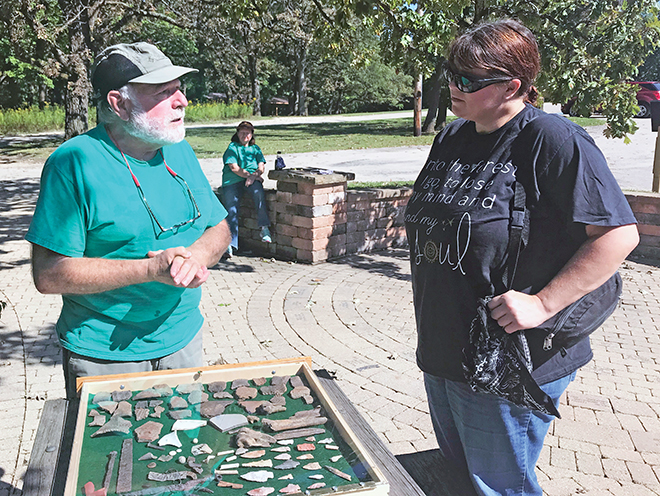Photogrammetry provides information for archaeological digs at Macktown Education Center

JEAN SEEGERS PHOTO The Herald
Peter Czyzewski discusses the collections of artifacts, including arrowheads and pottery shards with Naomi Orloski. Orloski recently moved to the area and would like to know more about the history of Mack-town.
By Jean Seegers
REPORTER
This summer, Lucas Howser, an archaeology graduate student at St. Cloud University in Minnesota, began utilizing a relatively new exploratory technique for pin-pointing excavation sites on the grounds of Macktown Living History Center, 2221 Freeport Road, Rockton.
Using a drone and high-resolution digital photography, Howser was able to study the topography of the land to pinpoint the location of probable archaeological sites.
Howser worked with Midwest Archaeological Research Services and Northern Illinois University Geophysical Field School over the summer, developing a high-resolution digital elevation model (DEM) using drones to survey the area.
The photogrammetry study was funded by a $2,500 grant from the Ecolab Foundation, and a $500 grant from the Stateline Community Foundation.
Macktown has been a rich source of artifacts dating back 7,000 years. “Archaeologists have discovered Native American artifacts, as well as remnants from pioneers of the 1850’s, at Macktown settlement,” Howser said.
Utensils, weapons, pottery shards, tools and arrowheads found have verified evidence of Native American and early settlers living at the settlement.
On Saturday, Sept. 12, visitors had the opportunity to observe the excavation of four archaeological sites. On Sunday, Sept. 13, Howser presented a program and photogrammetry demonstration.
Every June and July, archeology students from nearby colleges and universities excavate archeological sites on the grounds of Macktown. Sometimes they end up finding nothing. Other times they unearth a treasure-trove of artifacts.
Adults can sign up to participate in the one-week digs.
Children nine and up can also participate in a separate dig.
Because of the COVID-19 virus, the digs had to be cancelled this year, but, hopefully, will resume next summer.
The Photogrammetry program was part of the Second Sunday series at Macktown. This year, all programs are being held outside. The historic buildings are currently not accessible.
Self-guided walking tours feature informative signage at historically significant sites in the village.


